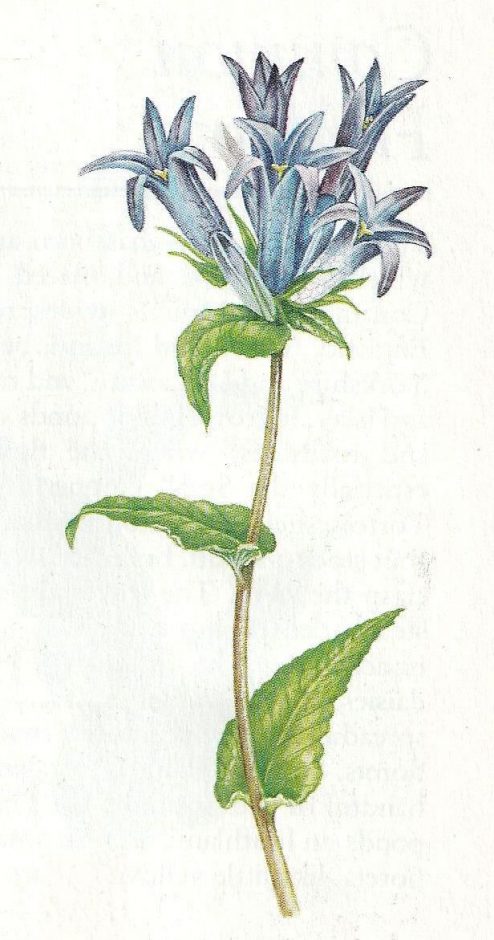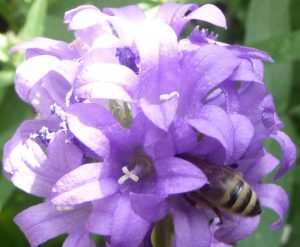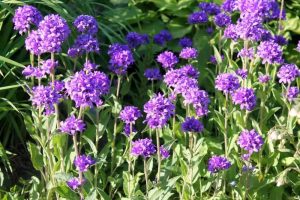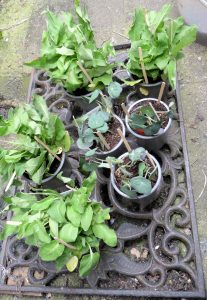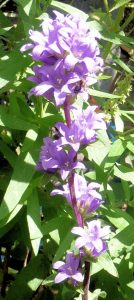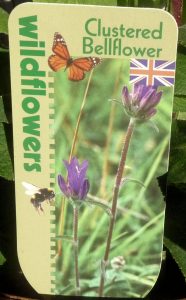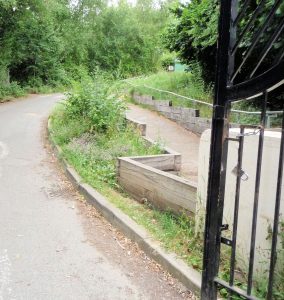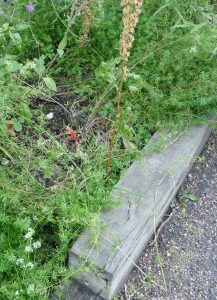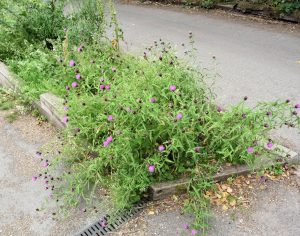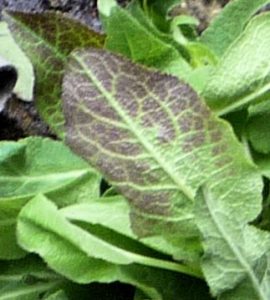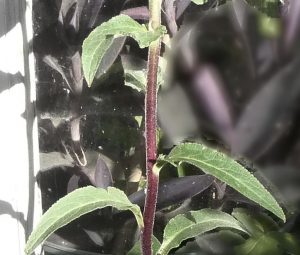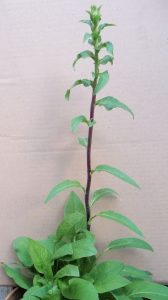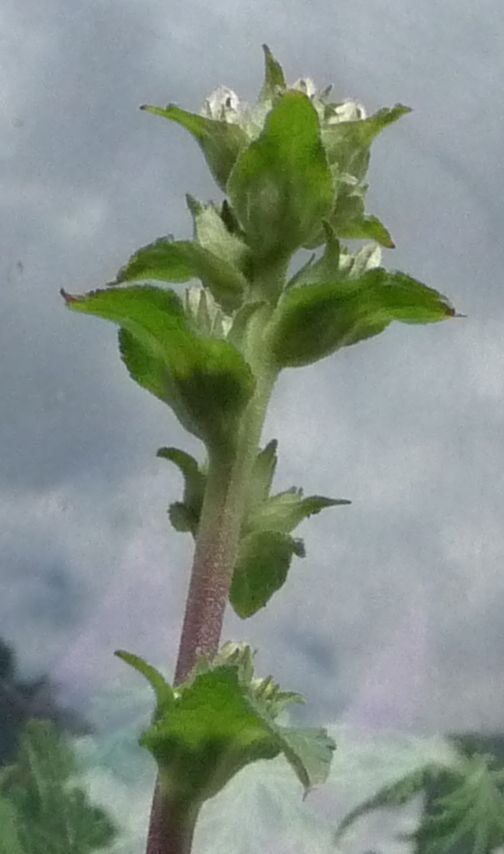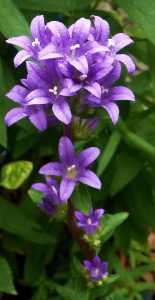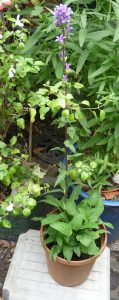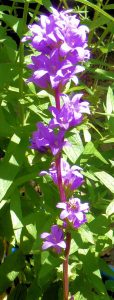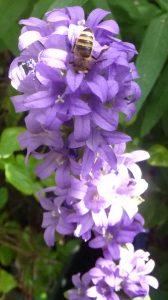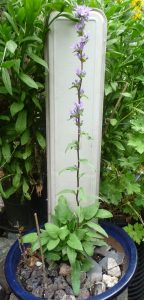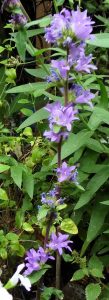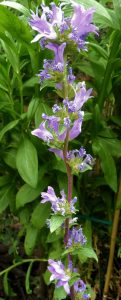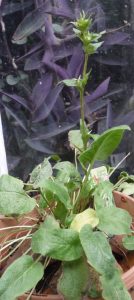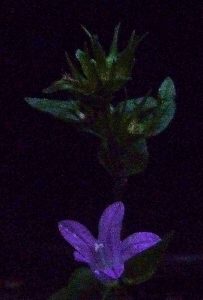CLUSTERED BELLFLOWER (Campanula glomerata/Danes Blood)
North Temperate Zone, from Britain to Japan
The Clustered Bellflower, native to the UK, is also found throughout Europe, Anatolia & Turkey as far east as Central Asia. Leaves of this vigorous perennial have a fine toothed edge & a matt surface. Tubular VIOLET-BLUE bells (campanula is Latin for ‘little bell’) appear at the top of its crimson stems in June, lasting until September.
Natural habitats for the Clustered Bellflower are forests, dry grasslands, scrub, open woodland, along roads & trails. In the UK “it is particularly common on the chalk downlands of southern England and limestone grassland as far west as Bath in Somerset… locally plentiful on sea cliffs and sand dunes.. “
*David Lang, The Illustrated Wildflower Finders Calendar, Ebury Press, London, 1983.
*Illustration by Linden Artists
Campanula glomerata is the county flower of Rutland, England. It grows, in sun or part shade, to 65cm x 30cm (BBC Gardener’s World Magazine). It is perennial & hardy in winter down to -45 degrees F.
Mix with sand before planting in soil that is well draned & rich in nutrients. Keep moist. Remove stems when flowers are done to encourage further flowering. Cut to ground level at season’s end to prevent seeds forming. Divide every 6 to 10 years.
Video below shows cutting back of Clustered Bellflower:
Edible
Campanula glomerata’s tuberous rootstock is edible with a taste similar to parsnip. The plant’s young leaves were also eaten in salads in the past in the Nordic countries. ‘The leaves are said to have a mild, sweet flavour and can be cooked or eaten raw as a salad ingredient. The flowers are also edible’. UK Plant Passport (plant identity tag)
Bees & other beneficial pollinators love the Clustered Bellflower. It is Perfect for Pollinators.
“The RHS Perfect for Pollinators mark is only given to plants that support pollinating insects in gardens. Bees, butterflies, moths, hoverflies and many others visit flowers to feed on nectar and pollen; while doing so they transfer pollen and increase seed set
and fruit development” wildflowersuk.com
Historical, legendary
“In the county of Cambridgeshire, the plant is known as Dane’s Blood, because it is said to grow prolifically on the Bartlow Barrows, said to have been thrown up by the Danes to commemorate a battle fought by Edmund Ironside and King Canute in 1006. ” UK Plant Passport (plant identity tag)
“Its red stems are said to be stained with the blood of Norsemen buried beneath ground.” PLANTLIFE
Part of the Jorvik Viking Festival finale battle celebrating a millenium since Canute claimed the throne of England’, the video below shows Boar snout attack Canute vs Edmund Ironside – Filmed by Rebecca Hill, who comments: ‘The Danish army gather into a Boar Snout formation and charge at the English Anglo-Saxon army.’
More about the Jorvik Viking Festival on our webpage, ‘Vikings at the bottom of our gardens‘ (Highbury’s Past)

Folk names – plants also known as Dane’s Blood in the UK
Plant-Lore looks at several other plants also associated with battles with the Danes.
Sambucus ebulus (Dwarf Elder), Pulsatilla vulgaris (Pasque Flower), Eryngium campestre (Field Eryngo), & Fritillaria meleagris (Fritillary). https://www.plant-lore.com/plantofthemonth/danes-blood/
Dane’s Blood Comes to Highbury
This is our first season growing the Clustered Bellflower/Dane’s blood. We hope it will succeed here, as it is a bee’s favourite & a winter hardy perennial. And we would like to commemorate the very probable battle between Danes & Saxons around 800AD a few streets from here. (See our ‘Vikings in the Bottom of our Gardens’ page for more.)

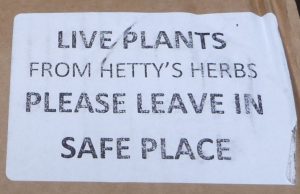
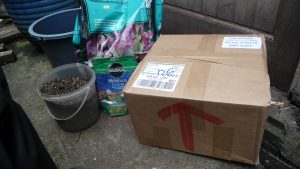 We ordered our plants from Hetty’s Herbs & Plants, a family-run independent business based in the Lincolnshire fens. Plants are packed w/ newspaper & straw, biodegradable substances rather than bubble wrap & plastic. Since their launch in 2018, Hetty’s have supported charities. The Hedgehog Preservation Society, The Peterborough Hedgehog Hotel & Up the Garden Bath have all benefited from plant sales.
We ordered our plants from Hetty’s Herbs & Plants, a family-run independent business based in the Lincolnshire fens. Plants are packed w/ newspaper & straw, biodegradable substances rather than bubble wrap & plastic. Since their launch in 2018, Hetty’s have supported charities. The Hedgehog Preservation Society, The Peterborough Hedgehog Hotel & Up the Garden Bath have all benefited from plant sales.
The no-signature-required delivery was by DPD (ZAPZERO LIMITED) who photographed the Hettys box sitting on the front doorstep.
Inside the box, with the plants, were instructions which included not planting up the Bellflowers straightaway… but allowing them to recover from the shock of transport.
May Be Invasive
The Clustered Bellflower can be invasive when it finds conditions to its liking. It has been introduced into other countries including the USA. Some gardeners, having tried to grow it & lost it, welcome any advice on how to keep it. Others struggle to remove it from their gardens.
One US website, Dave’s Garden, has a chat page where gardeners share their experiences:
fluffygrue from Manchester, United Kingdom (Zone 8a) wrote: ‘ I was hopeful that this might do well in our garden, as rockery campanulas are rampant here. Sadly this large plant was decimated by slugs/snails within a week of planting, so I wouldn’t recommend it for anyone with good slug/snail populations. Shame. ‘ April 26, 2006
No problem with invasiveness, just keeping the plant alive.
On the other hand, myrtleferndyke from Corning, New York wrote: ‘I am out there, day after day, no longer caring what else I destroy; I will eliminate this plant from my yard. Yes; it is pretty, but I want other plants, too. My soil is heavy clay, and it, apparently, loves the often wet conditions caused by poor drainage. Judging from my yard, shade or sun is fine, too. The leaves coming up this spring were as thick as grass on a lawn. I kid you not. The roots will grow under stone walk ways, the timbers of raised beds. Since I am an organic gardener, perseverance, a shovel and a trowel are my only weapons’. May 22 2022
 hekdek from Columbus, Ohio wrote ‘very striking plant. Blooms for 2-3 weeks here in early summer. Can be invasive so plant where it can be controlled‘. April 13 2009
hekdek from Columbus, Ohio wrote ‘very striking plant. Blooms for 2-3 weeks here in early summer. Can be invasive so plant where it can be controlled‘. April 13 2009
Marlina from Blaine, Maine wrote ‘very aggressive here … depends on what you want, whether it is a blessing or a curse.’ Aug 7 2009
Those fine, fibrous roots growing from the bottom of our small pot (left) wanted to create their tubers. Perhaps, for some of us, Danes Blood is best grown n a container.
Other Names: Angstoppklocka (Swedish); Campaneta (Catalan); Campanilla (Spanish); Campanula agglomerata (Italian); Campanule a Bouquets (French); Ciucure (Romania); Clychlys glwstwr (Welsh); Csomos Harangvirag (Hungarian); Dane’s Blood (British – Cambridgeshire); Dzwonek skupiony (Polish); Gronjasti zvoncic (Slovak); Ja ju kkot bang mang i (Korean); Kampanoula (Greek); Kerakell ukas (Estonian); Klobcasta zvoncica (Slovene); Kluwenklokje (Dutch); Knauelglockenblume (German); Livadna zvoncika (Croatian); Lulekambane (Albanian); Nogleblomstret klokke (Danish); Peurankello (Danish); Stars (British – Wiltshire); Toppkiokke (Norwegian); Yatsushiroh-so (Japanese); Yumak cani (Turkish); Zvonek klubkaty (Czech).
Two Bellflowers Donated to Gillespie Park
After all four of the Bellflowers were replanted from their 4in pots, two were given to the nature reserve at Gillespie Park on 24 June 2022. A volunteer planted them out next day. We will be following their progress & taking photos.
Triumph of the Molluscs
The Bellflowers were attacked by slugs and snails straightaway. There was nothing left of them by the time the photos below were taken a few days later. A bit of red tape marks the spot where they had been planted. It seems that Highbury slugs & snails are as formidable as those in Manchester. (fluffygrue of Manchester, Dave’s Garden quoted above, April 26, 2006).
Then There Were Two
Here in our garden one of the two remaining Bellflowers shows no desire to flower. It may still be recovering from the shock of transport. The other plant sent up a strong, rust-red stem : one can see how those who found this plant growing at the site of a battle might connect its red stem with the blood of fallen warriors.
Bellflower in Bloom
By 11th July the Danes Blood stem had reached its full height, & the buds at the top opened into a cluster of eight pastel BLUE- PURPLE Campanula bells.
Beautiful Bellflower
Danes Blood is an elegant wildflower. Its colour does not come true from these digital photos. The soft purple star flowers – nearly translucent – register as blue in shade or a washed out lavender in sun.
Danes Blood catches the morning sun on our bay window sill. After a few hours it is moved to the sunniest southeastern corner, where it spends the rest of its day with Purple Loosestrife & other bee-friendly plants. It seems safer to move it back close to the house overnight, when foxes, cats & mice visit the garden & pots may be knocked over.
Danes Blood Found by Pollinators
On 14 July 2022 the Bellflower was discovered by garden pollinators – primarily small bees.
The plant’s upper leaves project all round the stem, with buds sitting in the axils. The flower cluster at the stemtop opens first, followed by buds below, going down the stem. (Unlike the nearby Purple Loosestrife which opens its flowers from the bottom up.) Bees are slowly rising & descending along each stem, then diving into a flower.
If you want plants for pollinators, these two wildflowers will draw them in.
27 July 2022… Danes Blood flowers are now going over. The Bellflower has been repotted, and in accordance with Hetty’s instructions the stem will be cut down, in anticipation of a possible second flowering stem going into August.

Small pollinator in Bellflower 2nd stem cluster
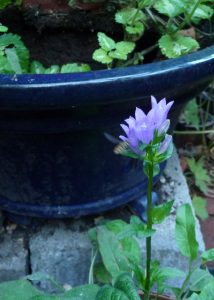
31st August – 2nd stem, 1st pollinator
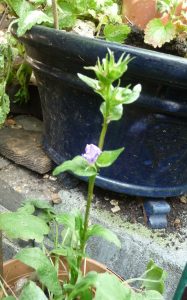
danes blood last flower
Second Stem
29th August. In mid-August, the Bellflower began putting up a second stem. Sunlight for the plant is weaker at this time of year, & there are fewer daylight hours in which to grow. Thus far the 9 inch stem has no blood red colouring.
Last Flower
In the end the Bellflower bloomed from 11 July to 24 September. An unexpected heavy rainstorm hastened its demise. Look at the youtube video at the top of the page.. flowers being cut back. This plant must be several years old, & be totally happy with its growing conditions. The second stem of our Danes Blood was never crimson.
Gardeners writing to Dave’s Garden said the plant looks ‘weedy’ & ‘ratty’ when it has finished flowering. No sign of that yet.
